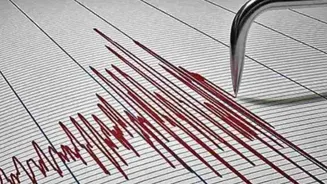Initial Seismic Activity
An earthquake, registering a significant 6.5 on the magnitude scale, was detected off the coast of Indonesia. This event sparked immediate attention due
to the considerable strength of the tremors. The specific location was a critical factor in evaluating the potential consequences. Authorities and seismologists began monitoring the situation closely to determine the extent of the impact and potential hazards. Initial reports focused on the quake's epicenter and depth, key determinants of potential damage and the likelihood of associated events, such as tsunamis. The intensity of the shaking was a primary concern, as this determined the immediate structural integrity of buildings and infrastructure in nearby areas. Moreover, the shallow depth of the earthquake added to the gravity of the situation, as it heightened the possibility of a destructive tsunami. Emergency services were put on high alert. The public was advised to stay informed through official channels.
Tsunami Risk Assessment
The shallow depth of the earthquake significantly amplified the risk of a tsunami. This prompted a swift and comprehensive assessment by meteorological and geological agencies. Scientists and experts analyzed data, including the quake's magnitude, depth, and location, to gauge the likelihood and potential scale of a tsunami. They utilized sophisticated modeling techniques to predict wave behavior and impact zones. Coastal areas were placed under heightened alert, with warnings issued to residents. Evacuation plans were activated in vulnerable regions as a precautionary measure. Furthermore, monitoring systems, such as buoys and tide gauges, were deployed to detect any abnormal sea-level changes indicative of a tsunami. The public was urged to remain vigilant and follow safety instructions provided by local authorities. The swift actions were aimed at minimizing potential loss of life and damage. Communication was key, with constant updates and alerts disseminated through various channels to inform the public and guide emergency responses effectively.
Local Area Impacts
The earthquake's impact varied across the affected areas, depending on factors such as distance from the epicenter and local geological conditions. Initial reports began to emerge about the extent of damage to infrastructure, including buildings, roads, and utilities. The intensity of shaking was the key factor in determining structural integrity. Assessments focused on the stability of buildings, paying close attention to any signs of damage such as cracks or collapses. Damage to roads and bridges disrupted transportation networks, hindering access to affected areas and impacting relief efforts. Utility failures, such as power outages and disruptions to water supply, presented immediate challenges for residents and emergency responders. Furthermore, communication networks may have been affected, making it difficult to coordinate responses and maintain contact with those in need. Local authorities worked quickly to assess the extent of the damage and to deploy resources to support those affected. Relief efforts were swiftly mobilized, with a focus on providing immediate assistance and addressing the immediate needs of the community.
Emergency Response Efforts
The earthquake triggered a coordinated emergency response involving local authorities, emergency services, and international aid organizations. Rescue teams were dispatched to affected areas to assess damage, search for survivors, and provide immediate assistance. They worked to clear debris, stabilize damaged structures, and extract those who may have been trapped. Medical teams were mobilized to treat injuries and provide healthcare support to affected populations. Temporary medical facilities and field hospitals may have been set up to handle the influx of patients. Shelters and evacuation centers were established to accommodate displaced people, offering them essential provisions, such as food, water, and shelter. Coordination between different response teams was crucial, and communication systems were vital to ensuring efficient operations. International aid agencies worked to mobilize resources, including personnel, equipment, and financial assistance, to support the relief efforts. The main objective of the emergency response was to save lives, provide humanitarian support, and restore essential services.
Community Resilience and Recovery
Following the immediate emergency response, the focus shifted towards the long-term recovery and rebuilding efforts. This phase would include assessing the overall impact of the earthquake, the extent of damage to homes, businesses, and essential infrastructure. The assessment was critical for prioritizing reconstruction efforts and allocating resources effectively. Plans for rebuilding damaged infrastructure were developed, with an emphasis on incorporating earthquake-resistant designs to mitigate future risks. Support programs were introduced to assist affected individuals and families in rebuilding their lives. This includes housing assistance, financial aid, and mental health services to help people overcome the trauma. Long-term recovery also encompassed the revitalization of local economies, including support for businesses and job creation. Community involvement was crucial throughout the recovery process, allowing people to participate in the planning and rebuilding of their communities. The goal was to build a more resilient society, making sure people were more prepared for future disasters.










